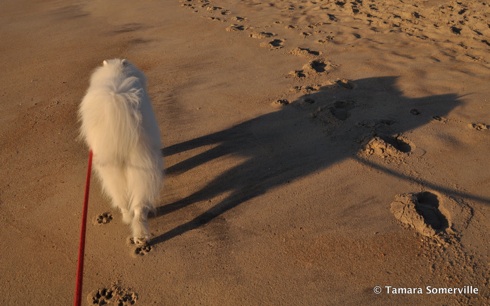







Gidget’s sunrise beach stroll on the day she nearly died.
We were nearing the end of day three of a vacation to the Outer Banks of North Carolina when my then 9-year old Samoyed, Gidget, began to exhibit what I suspected were symptoms of gastric dilatation volvulus (a.k.a. “bloat”). A pet first-aid book I keep in the car confirmed that she was symptomatic.
It was midnight and if we had been back home in Washington, D.C. I would have rushed her to our regular vet - a 24/7 hospital - and we would have been there in 20 minutes. But we were on vacation near the Hatteras Island lighthouse -- a six-hour drive from home -- and I had no idea where the nearest 24/7 emergency vet was.
There is only one highway on the Outer Banks - Highway 12 - so we headed north and while in the car started making phone calls. We discovered there are not any 24/7 veterinary hospitals on the Outer Banks. We also discovered that the one vet in Nags Head that advertises an emergency after-hours telephone number does not, in fact, always respond.
We left them a dozen phone calls while driving north and never received a call back. Fortunately, my regular vet in the DC area is also a 24/7 hospital so I called them and they guided us to an emergency facility near Norfolk, Virginia, with a surgeon on duty who was experienced in bloat procedure. It was 120 miles away. Our DC vet stayed on the phone with me for much of that drive.
Thankfully, that story had a happy ending -- Gidget survived with no lasting damage to internal organs. I had recognized and my DC vet confirmed the bloat symptoms quickly enough that even though we drove 120 miles we still, as bloat situations go, got Gidget treatment relatively quickly. Bloat symptoms are often subtle and not acted upon until it is too late.
That experience was instructive in a number of regards. Here’s what it taught me:
-
•Research and input into your GPS (and cell phones) the veterinary facilities closest to your vacation destination before leaving for your vacation. Make sure the list includes one or more 24/7 emergency veterinary hospitals and call to ensure that there actually is a surgeon on duty and on the premises 24/7. Put in your vehicle a hard-copy of a map showing all these vets.
-
•Know how you’re going to pay for emergency care. Before they would do surgery to save Gidget’s life, the veterinary hospital required that my credit card be charged $4000. They then deducted from that amount the expenses as they occurred. That is typical of veterinary hospitals, they have no legal obligation to care for your pet. The final tally for Gidget’s care was over $3000 -- relatively cheap for a bloat emergency. If you don’t have room on your credit card for major surgery then you’d better have a large cash stash or look into pet insurance (and before you go on vacation, make sure the emergency hospitals will accept that particular insurance). ATM cards typically have limits on daily withdrawals so do not assume that in the middle of the night you could just load up at a cash machine.
-
•Keep a Pet First-Aid book in your vehicle. Read it before you need it. It would even wiser to take a dog first-aid class.
-
•Keep a First-Aid kit in your vehicle. Commercial kits are available but you can probably assemble a better kit on your own and for less money. Your regular vet should be the best guide in assembling a kit for your dog. I periodically add this subject onto vet visits and the doctors have always been helpful in compiling a list of kit contents. For my kit container I use a small LL Bean “soft cooler.”
-
•Know what “shock” looks like. Another discussion to have with your vet before you go on vacation with your dog. “Shock” is the lack of adequate blood flow to vital organs. My vet showed me how to detect shock by pressing on Gidget’s gums. Your First-Aid book should explain this, too, but better to have your vet demonstrate on your own dog.
-
•Keep your vehicle’s fuel tank topped off. At least don’t let it go below half or as much as you need to get to the closest emergency vet. Minutes matter in an emergency so you do not want to be wasting time looking for an open gas station -- especially not in the middle of the night. And you sure do not want to run out of gas because you were so focused on the emergency you forgot to look at the gas gauge. Topping off your fuel tank is a good habit to get into, for a lot of reasons.
These simple preparations would greatly ease your stress in a crisis situation and could save your dog’s life. We humans (in America, at least) take for granted that we can dial 9-1-1 and an ambulance will race us to the nearest hospital.
Where our pets are concerned, we are their 9-1-1.
###
Addendum: another Samoyed fancier commenting on Facebook made the excellent point that these preparations also apply to relocating your home. Her family moved to a new area and a few days later, while they were still settling in, their dog needed an emergency vet but they had not yet mapped out the nearest hospitals. He survived, but they could have gotten him to the hospital more quickly by planning ahead.







Helpful Links













While on vacation, add a temporary tag to your dog’s collar that includes the phone numbers where you and/or a designee can be reached. A dog that wanders away on vacation is in even greater peril than one lost at home.


